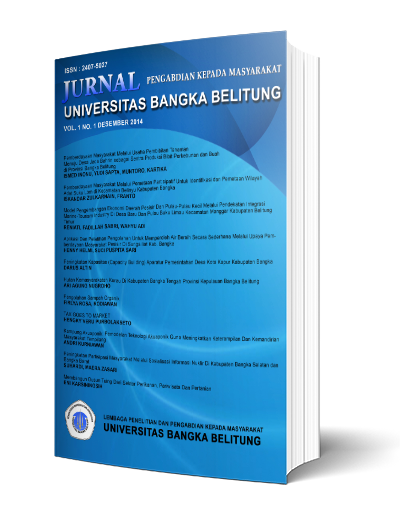Kampung Akuaponik: Modeling Aquaponics Technology To Improve The Skills And Self-Reliance Of The Tempilang Community
Kampung Akuaponik: Pemodelan Teknologi Akuaponik Guna Meningkatkan Keterampilan Dan Kemandirian Masyarakat Tempilang
Abstract
Utilization of narrow and unproductive land through fish farming is one way to increase land productivity. Aquaponic technology, which combines fish and vegetable farming with a recirculation system, is considered a simple but effective technology.
This technology emphasizes land efficiency and the utilization of fish organic waste as fertilizer for the plants on it. The development of this technology can produce multiple products in one production cycle. Furthermore, this technology is able to increase the independence and productivity of the community so that it is indirectly expected to support their economy and welfare.
KKN IX activities carried out by the Universitas Bangka Belitung (UBB) in Basun Village, Dam 3 Village, and Kelekak Kabung Village in Tempilang District are manifestations of the role of UBB's dharma of service to the community. The application of aquaponic technology is expected to bring new knowledge and skills to the community so that the optimization of non-productive land can be improved and able to produce something more useful and economically valuable.
Downloads
References
Anonymous. 2012. Deep Water Culture. http://en.wikipedia.org/wiki/Deep_water_culture. diakses pada 29 April 2013.
Anonymous. 2013. Drip Irrigation. http://en.wikipedia.org/wiki/Drip_irrigation. diakses pada 29 April 2013.
Diver, S. 2006. Aquaponics:Integration of Hydroponics with Aquaculture. ATTRA. www.attra.ncat.org.
Farran, I dan M. Castel. 2006. Potato Minituber Production Using Aeroponics : Effect of Plant Density and Harvesting Intervals. Amer. J.Pot. Res.83:47-53. In:Chiipanthenga, M., M. Maliro., P. Demo., dan J. Njoloma. 2011. Potential of Aeroponics System in The Production of Quality Potato (Solanum tuberosuml.) Seed in Developing Countries. African Journal of Biotechnology Vol.11(17), pp. 3993-3999. 2012.
Pade, J. S. 2010. Village Aquaponics. AquaponicsJournal.
Rakocy, J. E., D. S. Bailey., K. A.Shultz., dan W. M. Cole. 1997. Development of An Aquaponic System For The Intensive Production of Tilapia And Hydroponic Vegetables. Aquaponics Journal.
Kurniawan, A. 2013. Akuaponik: Sederhana Berhasil Ganda. UBB Press.
Kurniawan, A., A. Kurniawan., Muntoro., dan E.Asriani. 2013. Modelling of Aquaculture Development Based on Aquaponic In Bangka Belitung, Indonesia. Aquaponics Journal. Issue#62. 1stqtr 2013. Aquaponicsjournal.com.
Lee, C. W., I. S. So., S. W. Jeong., dan M. R. Huh. 2010. Application of Subirrigation Using Capillary Wick Systemto Pot Production. Journal of Agriculture & Life Science44(3) pp. 7-14.
Saavas, D. 2002. Nutrient Solution Recycling, p. 299–343. In: D. Saavas and H. Passam (eds.). Hydroponic Production of Vegetables and Ornamentals. Embryo Publications, Athens, Greece. In: Puerta, A. R., S. Sato., Y. Shinohara., dan T.Maruo. 2007. A Modified Nutrient Film Technique System Offers a More Uniform Nutrient Supply to Plants.
Thumma, D. W. 2013. How do I Make Homemade Hydroponic Systems for the Ebb & FlowSystem?. [Artikel]. http://www.ehow.com/how7186132do-systems-ebb-flow-system_.html diakses pada tanggal 29 April 2013.
Copyright (c) 2022 Andri Kurniawan

This work is licensed under a Creative Commons Attribution-NonCommercial 4.0 International License.








